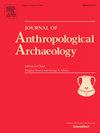Daily life in a New Kingdom fortress town in Nubia: A reexamination of physical activity at Tombos
IF 2.2
1区 社会学
Q1 ANTHROPOLOGY
引用次数: 0
Abstract
Previous analysis of skeletal indicators of physical activity suggested that the population at Tombos, an Egyptian colonial town in Nubia, may have benefited from an imperial framework through occupations that were not physically demanding. With more than ten years of continued excavations, coupled with further biomolecular testing, we reanalyze entheseal changes at Tombos. We compare entheseal changes between the three areas of cemetery, which house drastically different tomb types. Additionally, we also assess burial position (Egyptian, Nubian) and we incorporate the results of previous strontium isotope analysis to better understand the mortuary, socioeconomic, and occupational landscapes of this colonial space.
Our findings suggest that pyramid tombs, once thought to be the final resting place of the most elite, may have also included low-status high-labor staff. We support this argument with comparative data from Egypt and Nubia. Other cemetery areas seem to include individuals whose activity levels were more moderate. Nubian-style burials have relatively low entheseal scores, suggesting that they may have had low-labor occupations during the Egyptian colonial period, despite possibly identifying as Nubian. Lastly, locals and non-locals appear to have similar levels of physical activity, suggesting that migration status was also neither an advantage nor disadvantage in such a multicultural community. This study speaks to the importance of reanalyzing data; with continued excavations, dating, and biomolecular analysis, interpretations of lived experience in the past can be completely altered.
努比亚新王国堡垒城镇的日常生活:对汤博斯体育活动的重新考察
先前对骨骼运动指标的分析表明,在努比亚的一个埃及殖民城镇Tombos,人们可能受益于帝国的框架,从事不需要体力的职业。经过十多年的持续挖掘,再加上进一步的生物分子测试,我们重新分析了汤博斯的内在变化。我们比较了墓地的三个区域之间的墓葬变化,这三个区域的墓葬类型截然不同。此外,我们还评估了埋葬位置(埃及、努比亚),并结合了之前的锶同位素分析结果,以更好地了解这个殖民空间的殡葬、社会经济和职业景观。我们的发现表明,金字塔坟墓,曾经被认为是最精英的最后安息之地,可能也包括地位低下的高劳动人员。我们用埃及和努比亚的比较数据来支持这一论点。其他墓地区域似乎包括那些活动水平更温和的人。努比亚风格的墓葬有相对较低的附属物分数,这表明他们可能在埃及殖民时期从事低劳动职业,尽管可能被认定为努比亚人。最后,本地人和非本地人似乎有相似的体育活动水平,这表明移民身份在这样一个多元文化社区中既不是优势也不是劣势。这项研究说明了重新分析数据的重要性;随着持续的挖掘、年代测定和生物分子分析,对过去生活经历的解释可以完全改变。
本文章由计算机程序翻译,如有差异,请以英文原文为准。
求助全文
约1分钟内获得全文
求助全文
来源期刊

Journal of Anthropological Archaeology
Multiple-
CiteScore
4.00
自引率
11.10%
发文量
64
期刊介绍:
An innovative, international publication, the Journal of Anthropological Archaeology is devoted to the development of theory and, in a broad sense, methodology for the systematic and rigorous understanding of the organization, operation, and evolution of human societies. The discipline served by the journal is characterized by its goals and approach, not by geographical or temporal bounds. The data utilized or treated range from the earliest archaeological evidence for the emergence of human culture to historically documented societies and the contemporary observations of the ethnographer, ethnoarchaeologist, sociologist, or geographer. These subjects appear in the journal as examples of cultural organization, operation, and evolution, not as specific historical phenomena.
 求助内容:
求助内容: 应助结果提醒方式:
应助结果提醒方式:


